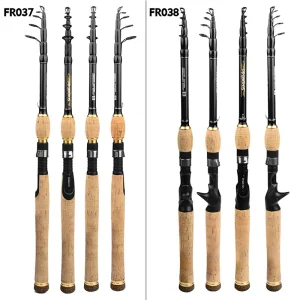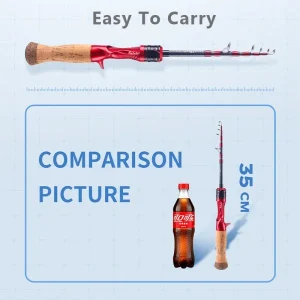
Fishing rods have changed a lot over time. They used to be made from bamboo. Now, we have materials like fiberglass, graphite, and carbon fiber. Each one has its strengths. Vintage fiberglass fishing rods are still loved for being tough, bendy, and rust-proof. They’re great for new anglers or rough fishing trips. On the other hand, modern graphite and carbon fiber rods are super light and very sensitive. These suits anglers who want precision in competitions. Composite blends mix these qualities for all-around use. Your fishing style, the fish you’re after, and your budget help you pick between the sturdy vintage fiberglass fishing rods and the high-tech carbon fiber ones. Brands like Laike Fishing use skilled craftsmanship to make rods for every angler’s needs.
What Are the Most Common Materials Used in Fishing Rod Construction?
Fishing rods have come a long way. Today, anglers have lots of choices. Long ago, bamboo was the main material for rods. It was valued for being flexible and strong. But now, we use modern stuff like fiberglass, graphite, carbon fiber, and composite blends.
Fiberglass got popular in the 1950s. It’s cheap and super tough. Later, graphite and carbon fiber came along. They’re much lighter and feel better. According to a 2023 Fact.MR report, fishing rods made up 65.5% of the sports fishing gear market. You’d need to dig deeper into their report for exact material breakdowns (Source: www.factmr.com). Composite rods mix these materials. They balance strength and sensitivity for different fishing needs.
How Have Fishing Rod Materials Evolved?
Switching from bamboo to man-made materials was a big deal for fishing. Fiberglass rods ruled from the 1950s to the 1970s. They were strong and flexible for their time. As anglers wanted lighter rods with better feel, graphite and carbon fiber became popular in the 1980s and later.
Today, rods use fancy weaving methods and special glues. These make rods stronger but lighter. A 2024 study by the Materials Research Society showed that new carbon fiber weaving cut rod weight by 18%. It also boosted strength by 22% compared to 2020 rods. This helps you cast better and fight fish easier (Source: Materials Research Society). These changes let you fish for different species in all sorts of places with the right gear.
Why Are Vintage Fiberglass Fishing Rods Still Popular?
What Makes Fiberglass Rods Strong Yet Flexible?
Vintage fiberglass fishing rods bend in a smooth, curved way. This makes them great for fighting big, strong fish. They don’t break easily. Their slow bend also softens wild fish shakes. So, hooks don’t pull out as often.
Can Fiberglass Withstand Harsh Conditions Over Time?
Yes, fiberglass fights off rust and damage from the sun or salty water. Even after years, vintage fiberglass fishing rods stay strong. They often last better than old graphite rods. A 2023 study by the Coastal Conservation Association found fiberglass rods kept 92% of their strength after five years in salty water. Old graphite rods only kept 78%. This shows why they’re great for tough fishing spots (Source: Coastal Conservation Association).
How Does Casting Performance Compare to Modern Rods?
Fiberglass isn’t as snappy as graphite. But it casts smoothly. It loads up nicely when you swing. This is forgiving for new anglers. It’s also good for lures like crankbaits or topwater baits. For these, how the bait moves matters more than pinpoint aim.
Is There a Modern Version That Captures This Classic Feel?

You bet! Laike’s Classic Fiberglass Series brings back the old-school vibe of vintage fiberglass fishing rods. But it adds modern touches like comfy handles and rust-proof guides. It mixes the best of old and new craftsmanship.
Are Modern Fishing Rod Materials Really That Much Better?
Why Choose Graphite or Carbon Fiber Over Fiberglass?
Graphite and carbon fiber rods are way lighter than fiberglass. This cuts down on tired arms during long fishing days. Carbon fiber fabric, the main stuff in carbon fiber rods, comes in different types. Quality varies, so prices do too. These rods also pick up tiny fish bites faster because they carry vibrations better.
What Benefits Do Composite Blends Offer?
Composite rods mix carbon fiber and fiberglass. They give you both sensitivity and toughness. These are awesome if you want one rod that works well for lots of fishing styles. They’re not too specialized.
Do Material Differences Impact Real-World Fishing Results?
Yes, they do. Lighter rods mean less arm ache after hours of casting. Sensitive rods help you set hooks better. In big tournaments or when chasing tricky fish, these perks can make or break your day.
Which Series Offers Top-Tier Performance Using Modern Tech?
If you love precision, check out Laike’s CarbonTech Series. It uses top-notch engineering with super-light carbon fiber blanks. These rods shine in both freshwater and saltwater fishing.
How Do Vintage Fiberglass Rods Compare to Today’s Options?
Is There a Noticeable Weight Difference on the Water?
For sure. Modern carbon fiber rods are much lighter than vintage fiberglass fishing rods. A 2023 Angling Trade study said 1970s 7’ fiberglass rods weighed about 9.2 oz. But 2024 carbon fiber rods average just 3.5 oz. This cuts fatigue by up to 30% on long trips (Source: Tackle Warehouse).
Does Lighter Gear Reduce Fatigue During Long Sessions?
Yes, it does. Pair light rods with light reels and soft grips like EVA or cork. This makes fishing feel easier over time.
Is Transporting Modern Rods Easier?
Modern rods often fold up or come in pieces. This makes them simple to pack. Older fiberglass rods were usually one long piece, which is harder to carry.
Which Material Offers Better Bite Sensitivity?
Graphite and carbon fiber win here. They’re stiff and light, so they feel best.
Can You Detect Subtle Bites Faster With Newer Rods?
You sure can. Newer rods pass vibrations quickly. You feel tiny nibbles fast. This lets you react before the fish spits out the bait.
How Do Hook-Setting Speeds Differ by Material Type?
Graphite rods have quick tips. They transfer energy fast when you set the hook. This is key for fish like bass or trout that strike fast.
Are Certain Techniques Better Suited for Each Material Type?
Yes. Slow-bend fiberglass is great for trolling or using crankbaits. These need steady pulls, not twitchy moves.
Which Works Best in Freshwater vs Saltwater Settings?
Fiberglass is awesome in saltwater. It fights rust well. Graphite is better for freshwater, where feeling tiny bites matters more than raw strength.
When Should You Use One Over the Other?
For laid-back fishing from shore or trolling all day, vintage fiberglass fishing rods are easy and fun. For tricky techniques like jigging or drop-shotting, go with modern rods every time.
How Should You Choose Based on Your Needs?
What Factors Influence Material Selection Most Heavily?
Your skill level, fishing style, target fish, and budget all matter. They guide you to the right rod material.
Are Beginners Better Off With Durable Options Like Fiberglass?
Yes. If you’re new or want gear that can take a beating, fiberglass is worry-free. It’s also cheaper.
When Is High-Sensitivity Gear Worth It?
Skilled anglers love graphite or carbon fiber rods. They feel bites fast, especially in clear water where fish are picky.
Does Price Always Reflect Quality Differences Between Materials?
Not always. Some composite rods give great performance without costing a ton.
What Do Experts Recommend for Different Scenarios?
For simple, reliable fishing, try Laike’s Fiberglass Models. They’re perfect for casual anglers who fish all year. For precision, go with Laike’s CarbonTech Line. It’s built for serious sport fishing.
How Important Is Craftsmanship Beyond Just the Materials Used?
Why Does Build Quality Matter So Much in Performance?
Even the best materials flop if put together poorly. Where guides sit affects how far you cast. Reel seats change the balance. Handle design helps you stay comfy and in control when fighting fish.
What Components Make a Noticeable Difference on the Water?
FUJI guides let the line flow smoothly. EVA grips feel good in your hand. Strong reel seats keep everything steady. These all make fishing better.
How Does Laike Maintain Consistent Quality Across Its Range?
Tianjin Laike Co., Ltd has made fishing gear for over 10 years. They have a factory in Weihai and work with over 200 tackle factories in China. They ensure top quality and deliver orders on time.
Should Sustainability Influence Your Choice Too?
Do Different Materials Have Varying Environmental Impacts?
Yes. Making carbon fiber uses more energy than fiberglass. But carbon fiber lasts longer, which might balance things out. Carbon Fiber Handles are pricey but sleek. They’re molded in one piece for a cool look. You can add bright colors. They also give great sensitivity and a super strength-to-weight ratio.
Can Damaged Rods Be Repaired Easily Depending on Material Type?
Fiberglass is easier and cheaper to fix than high-tech graphite. Graphite often needs whole sections replaced if it breaks. Carbon Fiber Handles are tough. Even if banged up, a quick heat treatment with a hot air gun can fix them right up.
How Are Manufacturers Supporting Eco-Friendly Angling Practices Today?
Brands that care about the planet focus on sturdy builds to cut waste. They also offer recycling programs and green packaging. Laike supports one-stop shopping with flexible order options.
FAQ
Q1: Are vintage fiberglass fishing rods still usable today?
A: Yes! Many old rods still work great because they’re built tough. If cared for, they’re awesome for catching big fish that need a strong, bendy rod instead of super-precise control.
Q2: What’s better for beginner anglers: graphite or fiberglass?
A: Fiberglass is usually better. It’s forgiving and tough against damage. This is great while you learn to cast and figure out how fish act.
Q3: How do I know which rod material suits my preferred technique?
A: Pick a rod that fits your fishing style. Use sensitive carbon or graphite rods for finesse methods like jigging. Go with tough fiberglass for trolling heavy lures or fishing in rough spots.




